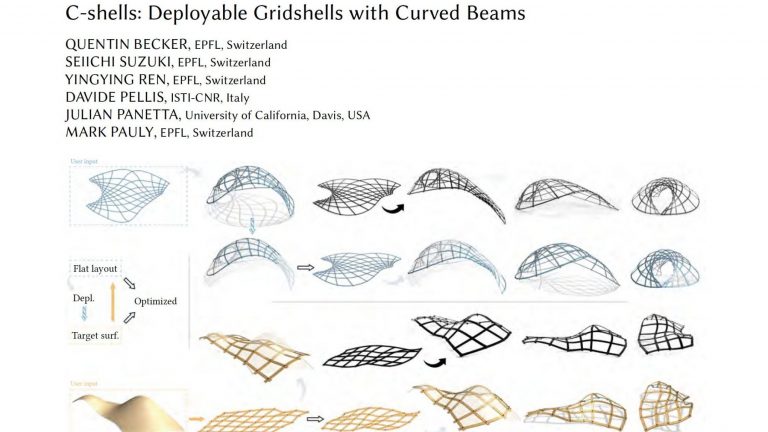C-shells
C-shells are bending-active deployable structures made of slender curved beams.
- Project description:
- We introduce a computational pipeline for simulating and designing C-shells, a new class of planar-to-spatial deployable linkage structures. A C-shell is composed of curved flexible beams connected at rotational joints that can be assembled in a stress-free planar configuration. When actuated, the elastic beams deform and the assembly deploys towards the target 3D shape.
We propose two alternative computational design approaches for C-shells: (I) Forward exploration simulates the deployed shape from a planar beam layout provided by the user. Once a satisfactory overall shape is found, a subsequent design optimization adapts the beam geometry to reduce the elastic energy of the linkage while preserving the target shape. (ii) Inverse design is facilitated by a new geometric flattening method that takes a design surface as input and computes an initial layout of piecewise straight linkage beams. Our design optimization algorithm then calculates the smooth curved beams to best reproduce the target shape at minimal elastic energy.
We find that C-shells offer a rich space for design and show several studies that highlight new shape topologies that cannot be achieved with existing deployable linkage structures.
C-shells are composed of curved elastic beams connected with rotational joints. Upon torque actuation, the linkage must buckle out of plane due to the geometric incompatibilities introduced in the flat linkage. Below is a minimal example showing the concept of geometric incompatibilities.
Depending on the actuation sequence, some C-shells may deploy in distinct deployed states such as our half-torus example below.
Publications
Please note that the publication lists from Infoscience integrated into the EPFL website, lab or people pages are frozen following the launch of the new version of platform. The owners of these pages are invited to recreate their publication list from Infoscience. For any assistance, please consult the Infoscience help or contact support.


